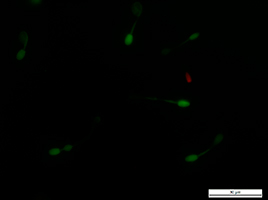
Seminarios de Actualización del Instituto de Investigación y Tecnología en Reproducción Animal (INITRA) 2019
Tema: Mecanismos regulatorios del calcio asociados a la capacidad fecundante de los espermatozoides
Director: Dr. Daniel LOMBARDO.
Coordinadoras: Mg. Teplitz, Gabriela y Dra. Fumuso, Fernanda
Descripción: El objetivo es establecer un ámbito de intercambio de ideas para favorecer la aplicación de las investigaciones en curso a la resolución de problemas suscitados en la práctica. Las temáticas abordadas serán:
Tema: Mecanismos regulatorios del calcio asociados a la capacidad fecundante de los espermatozoides
Fecha: 30 de agosto de 2019.
Disertante: Mariano Buffone
Carga horaria: 2 horas
Resumen: Sperm acquire the ability to fertilize in the female genital tract in a process called capacitation. During capacitation sperm undergo a change in the motility pattern called hyperactivation (HA) and acquire the ability to undergo acrosomal exocytosis (AR) which are critical to fertilization.
Ca2+ is the primary second messenger that triggers HA motility and it depends on CatSper channels. It has been described that CatSper1 proteins form a unique pattern of four linear ‘‘stripes’’ running down the principal piece of the flagellum. Catsper Ca2+domains orchestrate the timing and extent of complex phosphorylation cascades because it colocalizes with Ca2+signaling molecules.
On the other handAR is controlled by several players and one of them seems to be the actin cytoskeleton. Most studies to evaluate actin polymerization (formation of filamentous actin or F-actin) in sperm were performed using phalloidins, which are toxic and not capable of crossing the cell plasma membrane.
We have used the powerful capabilities of super-resolution microscopy to reveal the location and regulation of signaling molecules in the sperm tail and for the first time, how are the dynamic changes in of the actin cytoskeleton at the onset of the AR.Our work also emphasizes the utility of live-cell nanoscopy for the study of sperm ultra-structures, where these imaging capabilities will undoubtedly impact the search for mechanisms that underlie basic sperm functions.
No se requiere inscripción.
No arancelado